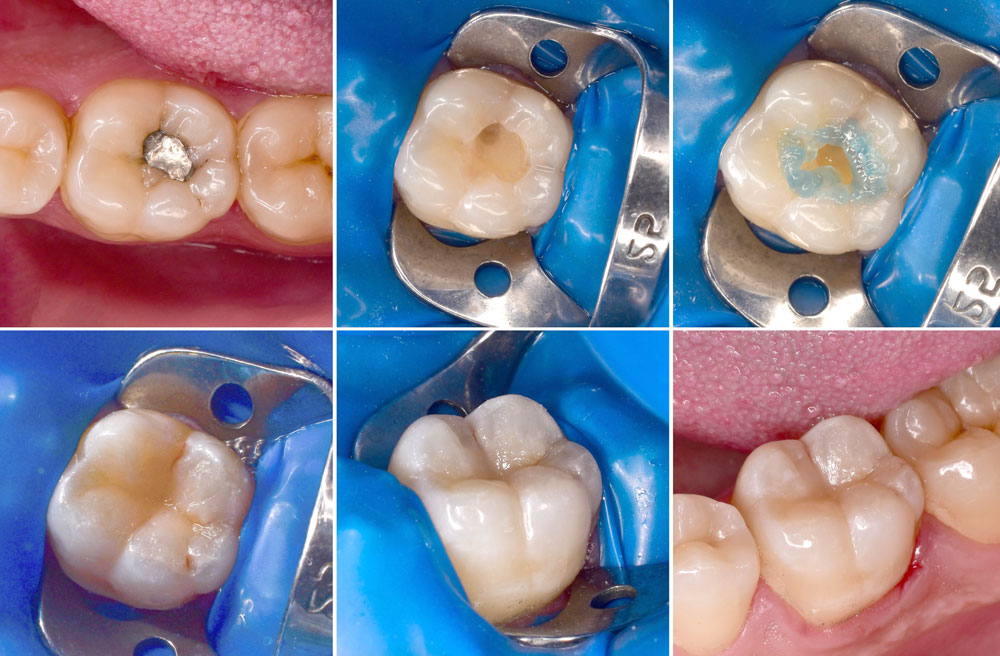Cosmetic Dentistry

Teeth Filling Amalgam Filling Removal
Recent advances in dental material science and technology have changed the face of dentistry. The old amalgam (or silver) fillings have been replaced by tooth coloured Composite Resins. The bonding of composite resin is more conservative for the tooth being repaired as it requires less tooth structure removed (drilled away) compared to amalgam fillings. Furthermore, composite resin material is much safer alternative compared to amalgam. They don’t contain mercury or expand in function causing the tooth to potentially crack.
Here at Bundall Dental And Implants we utilise composite resins and other biocompatible tooth-colour materials for both new restoration (fillings) and replacing old amalgam fillings.
Frequently Asked Questions about Amalgam Filling Replacement (FAQs)
Tooth-coloured fillings are made from composite resin materials that combine plastic compounds with finely ground glass particles. These biocompatible materials are designed to match the natural colour of your teeth and are typically BPA-free. Unlike traditional amalgam fillings that contain mercury and various metals, composite resin fillings offer a more aesthetic alternative while providing functional tooth restoration. The specific shade can be customised to blend with your surrounding teeth, helping maintain a natural appearance.
Amalgam replacement involves carefully removing existing metal fillings and replacing them with tooth-coloured composite resin alternatives. The procedure typically begins with numbing the treatment area for your comfort. Your dentist will then safely remove the old amalgam filling, clean the cavity thoroughly, and prepare the tooth surface. The composite resin is applied in layers, with each layer being hardened using a special curing light. Finally, the filling is shaped and polished to ensure a comfortable bite and natural appearance. The entire process usually takes between 30-60 minutes per tooth, depending on the size and location of the filling.
Modern composite resin fillings have evolved significantly and can provide long-lasting tooth restoration when properly placed and maintained. While amalgam fillings have historically been known for their durability in high-pressure areas, advances in composite materials have narrowed this gap considerably. The longevity of any filling depends on factors including its size, location, your oral hygiene practices, and dietary habits. Many patients find that composite fillings can last 7-10 years or longer with proper care. Your dentist can assess your specific situation and recommend the most appropriate filling material based on the tooth location and extent of restoration needed.
Replacing metal fillings with tooth-coloured alternatives offers several potential benefits. Aesthetically, white fillings are designed to blend seamlessly with your natural teeth, making them virtually invisible when you smile or speak. From a functional perspective, composite resin bonds directly to the tooth structure, which may help support the remaining tooth and potentially require less removal of healthy tooth material during placement. Additionally, composite fillings don’t contain mercury, addressing concerns some patients have about metal-based materials. They also don’t conduct temperature as readily as metal, which may reduce sensitivity to hot and cold foods. However, the suitability of amalgam replacement depends on individual circumstances, and your dentist can help determine if this option is appropriate for you.
When performed by a trained dental professional using appropriate safety protocols, amalgam removal can be conducted safely. Dentists typically use several protective measures during the procedure, including high-volume suction to minimise any mercury vapour exposure, rubber dam isolation to prevent material from being swallowed, and copious water irrigation to cool the tooth and wash away particles. The tooth is sectioned carefully to remove the filling in larger pieces rather than grinding it entirely, which helps reduce aerosol generation. If you have specific concerns about amalgam removal, discuss them with your dentist, who can explain the safety protocols used in their practice.
The cost of amalgam replacement varies depending on several factors, including the number of fillings being replaced, the size and location of each filling, and the complexity of the procedure. Generally, composite resin fillings may cost more than traditional amalgam fillings due to the materials used and the technique-sensitive nature of the placement process. At Bundall Dental, we provide transparent pricing and can discuss payment options during your consultation. We recommend scheduling an examination so we can assess your specific needs and provide an accurate cost estimate tailored to your situation. Some private health insurance policies may provide coverage for filling replacement, and our team can help you understand your benefits.
Some patients may experience temporary sensitivity to temperature or pressure following composite filling placement, though this is not universal. If sensitivity occurs, it typically subsides within a few days to a couple of weeks as the tooth adjusts to the new filling. The level of sensitivity can depend on factors such as the depth of the filling, proximity to the nerve, and individual patient sensitivity. Modern bonding techniques and materials have been developed to help minimise post-operative sensitivity. If you experience persistent or severe discomfort after your procedure, contact your dentist for an evaluation, as adjustments can sometimes help resolve the issue.
Caring for composite resin fillings involves the same good oral hygiene practices recommended for natural teeth. Brush twice daily with fluoride toothpaste, floss daily to remove plaque between teeth, and attend regular dental check-ups and professional cleanings. While composite fillings are durable, they can be affected by excessive force, so if you grind or clench your teeth, your dentist may recommend a nightguard for protection. Certain habits like chewing ice, biting hard objects, or using your teeth as tools should be avoided as they can damage both natural teeth and fillings. Some foods and beverages with strong pigments (coffee, tea, red wine) may cause slight staining over time, though this is typically minimal with modern composite materials. Your dentist can polish your fillings during routine visits to help maintain their appearance.
teeth filling | amalgam filling | temporary tooth filling | temporary filling | amalgam filling removal | tooth filling near me





